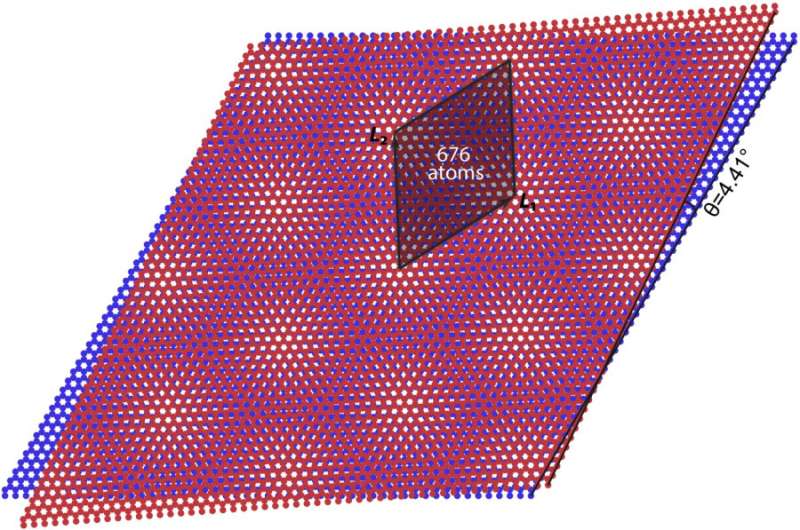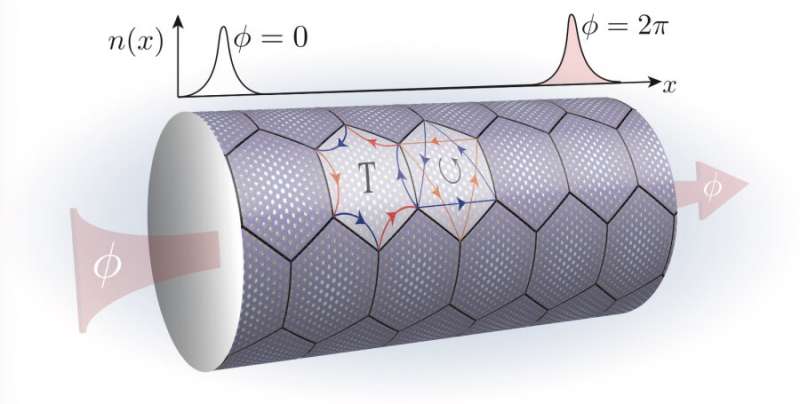Physicists demystify magic: bona fide topological Mott insulator discovered in twisted bilayer graphene model

Imagine stacking two sheets of graphene—the 2D form of graphite, or the pencil at your hand—in which the carbon atoms form a hexagonal lattice and twist the top sheet out of alignment with the sheet below, yielding a periodic arrangement of atoms named moiré pattern. Do you know that at a twisted angle of about 1°—people now call it the 'magic' angle—the system could exhibit very exotic behaviors such as becoming an insulator, a metal or even a superconductor? Can you imagine the same carbon atom in your pencil (graphite) becoming a superconductor when twisted to the magic angle? It indeed did as people discovered it in 2018, but why? A team of researchers from the Department of Physics at the University of Hong Kong (HKU) and their collaborators have succeeded in discovering a bona fide topological Mott insulator in twisted bilayer graphene model. The findings have been published in a renowned journal Nature Communications.
The reasons behind these exciting phenomena are the frontiers of condensed matter physics and quantum material research, both experimental, theoretical and computational, usually in combined form. The basic understanding up to now is that once the two graphene sheets form moiré patterns at the magic angles, the energy bands of electrons in the twisted bilayer graphene become almost flat, in other words, the velocity of the electrons on the lattice becomes considerably lower than usual (compared to that in single-layer graphene or graphite—our pencil), thus, the density of the electrons for this specific energy is tremendously large and the electrons can interact with each other strongly, giving rise to many unexpected states, e.g., the super-conductor, quantum Hall effect.
As a result, the behavior of the electron is dominated by the mutual repulsive (Coulomb) interactions, which leads to the emergence of the exotic phases discussed above that do not exist in single layers of graphene or our pencil. At low temperatures (below 10 Kelvin), when the electron number is tuned to fill integer degrees of freedom of the flat bands, it means some of these bands are fully occupied while leaving the others fully empty, the system then would form an electrically insulating phase. Moreover, when the electron number deviates from the integer fillings, the system becomes either a metal (with low electrical resistivity) or a superconductor (zero resistance).
The phenomena of the magic angle twisted bilayer graphene are rich and profound, and physicists all over the world are now trying very hard to build proper microscopic models and find powerful computation methodologies to capture the mysterious properties of these models. Recently, Dr. BinBin Chen and Dr. Zi Yang Meng from the Department of Physics, HKU, in collaboration with institutions from China and the US, succeeded in doing so with substantial progress. They have demystified the phase diagram of a model with a specific density of electrons and have identified the experimentally observed quantum anomalous Hall state, which is a novel quantum state with dissipationless edge current and is promising to be used as a basic component of your daily electronic gadgets, e.g. computer, smartphone.
Quantum anomalous Hall effect in effective twisted bilayer graphene model

Researchers pay special attention to the ν=3 integer filling of the magic angle twisted bilayer graphene, since at the same filling case, the experiment shows that in the alignment of hexagonal boron nitride substrate, the electrons exhibit quantised Hall conductance σxy=e2/h without exerting a magnetic field—the so-called the quantum anomalous Hall (QAH) state. The QAH state is an interesting topological state with the bulk remaining insulating and the edge conducting electric current without dissipation! Till now, the mechanism of such QAH state is still under debate. In the work, researchers show that such an effect can be realized in a lattice model of twisted bilayer graphene in the strong coupling limit, and interpret the results in terms of a topological Mott insulator phase.
Specifically, researchers present their theoretical study on the mechanism of QAH driven by projected Coulomb interactions. By employing extensive density-matrix renormalisation group simulations on the interacting lattice model, they identify a QAH phase with Hall conductance of σxy=e2/h , which is separated from an insulating charge density wave (stripe) phase by a first-order quantum phase transition at αc ≃ 0.12. To calculate the Hall conductance in the QAH phase, they actually follow Laughlin's gedankenexperiment. That is, by inserting a flux φ slowly from 0 to 2π through the hole of the cylinder, we observe exactly one electron is pumped from the left edge to the right, corresponding to the quantized Hall conductance of σxy=e2/h. This work addresses the currently popular question on the origin of QAH in twisted bilayer graphene at ν=3 filling.
The first instance of topological Mott insulator
The QAH state discovered from model computation purely comes from the unique properties of the Coulomb interaction in the magic-angle twisted bilayer graphene system. And it is the first example of such an interaction-driven topological quantum state of matter that has been unambiguously discovered. The impact of such discovery is even beyond the area of magic-angle twisted bilayer graphene and have responded to a proposal in the generic topological state of matter a decade ago.
One of the reviewers, Dr. Nick Bultinck, a theoretical condensed matter theorist from the University of Oxford, gave a high rating of the work and said: "In his seminal paper, Haldane has shown that one does not need a magnetic field to have electrons occupy topologically non-trivial extended states which respond to Laughlin's adiabatic flux insertion by producing a quantised Hall current. The results in this work show that one does not even need a kinetic energy term in the Hamiltonian for this to occur."

Indeed, not limited to the twisted bilayer graphene system, our work, for the first time, provides a Mott-Hubbard perspective for the QAH state driven by interactions only. Consequently, we clarified the long-standing mystery of the possible existence of the topological Mott insulator (TMI), the building block of the so-called information highway due to its ability to transfer electricity and information without loss.
The famous Chinese-American physicist, Professor Shou-Cheng ZHANG (1963-2018) and his collaborators first proposed such a TMI state about a decade ago, and subsequently, various interaction models have been studied by many theorists. Among all the previous works, the kinetic terms play a crucial role in the emergence of the QAH, and therefore, the obtained state should not be dubbed as "TMI". However, our model completely turns off the kinetic part and contains only the interactions to produce the TMI state. In this regard, our work bridges the two essential fields in condensed matter physics: topology and the strong correlation. Further extension of our model construction and unbiased quantum many-body computations can be accessed from here.
Impact and future directions
As the number of transistors in the chips of our computer is doubled every 18 months, the heat they generated accompanied with the electricity transfer is gradually becoming a severe problem. The discovery of quantum anomalous Hall effect is of great significance, as no dissipation of energy and no heat is generated in the edge. In practice, such a state is the building block of the information highway and is promising to be applied in the next-generation chip.
The discovery of the QAH as the topological Mott insulator state in our model computation at filling v=3 sheds light on the phases that occur in magic-angle twisted bilayer graphene. Further careful modeling and computation on the lattice models of the system would reveal the mechanism of the superconductivity and provide better tunability of these exotic phenomena in this and other 2D quantum moiré material. The new findings also leave many open questions. For example, why is the topological Mott insulator state absent at other fillings of the band structure of the magic-angle twisted bilayer, how to properly study and compute the properties of the model away from integer fillings, etc? "The answers to these questions might help physicists to fully demystify the magic in this material and design more exciting phases of matter in this and other 2D quantum moiré materials currently being actively studied." Dr. Meng added, "And our research activity and expertise in 2D quantum materials can substantially boost this direction, which is the strategical research themes of HKU."
More information: Bin-Bin Chen et al, Realization of topological Mott insulator in a twisted bilayer graphene lattice model, Nature Communications (2021). DOI: 10.1038/s41467-021-25438-1
Journal information: Nature Communications
Provided by The University of Hong Kong




















